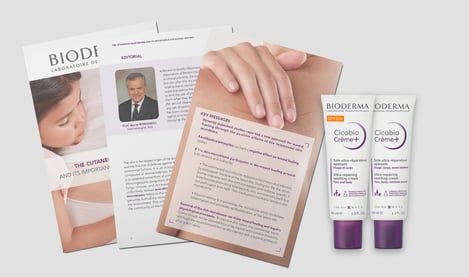1 professionals
Bioderma Congress Reports EWMA 2024
Bioderma Congress Reports EWMA 2024
Get access to exclusive dermatological services to increase your professionnal knowledge: +500 pathology visuals, clinical cases, expert videos
Benefit from valuable features: audio listening, materials to be shared with your patients
Stay informed about the upcoming events and webinars, latest scientific publications and product innovations
Already have an account? login now
Reports written by Dr. Elena Conde Montero (Dermatologist, Spain)
Related topics
Speakers: Dr. Linda Aiken, Prof. Anne Marie Rafferty and Naseer Ahmad
Linda Aiken (Pennsylvania, United States)
The first question is: Why don’t proven clinical interventions have their intended outcomes? There is no direct relation between interventions and outcomes. However, it has been described that several patient outcomes are associated with Patient-to-Nurse Staffing Ratios:
Recent USA data show that 63% of the nurses work in a chaotic environment (Reports from RNs in 357 USA hospitals, 2021).
So, what is the problem to solve?
And what are the implications for Practice and Research?
Anne Marie Rafferty (London, United Kingdom)
The main message of the talk is that shortage of nurses should be treated as a global health emergency. It highlights the conclusions of a paper that in 2019 took the 70th Anniversary of the National Health Service (NHS) in the United Kingdom as an opportunity to reflect upon the strategic direction of nursing policy and the extent to which nurses can realise their potential as change agents in building a better future for health care (Nurses as change agents for a better future in health care: the politics of drift and dilution. Health Econ Policy Law. 2018;13(3-4):475-49). It argues that the policy trajectory set for nursing at the outset of the NHS continues to influence its strategic direction, and that the trajectory needs to be reset with the voices of nurses being more engaged in the design, as much as the delivery, of health policy. There is a growing evidence base about the benefits for patients and nurses of deploying well-educated nurses at the top of their skill set, to provide needed care for patients in adequately staffed and resourced units, as well as the value that nurses contribute to decision-making in clinical care. Yet much of this evidence is not being implemented. On the contrary, some of it is being ignored. Policy remains fragmented, driven by short-term financial constraints and underinvestment in high quality care. Nurses need to make their voices heard, and use the evidence base to change the dialogue with the public, policy makers and politicians, in order to build a better future for health care.
Studies are needed to know more about the role of professional judgement in staffing methodologies, or its contribution to decision-making, such as the one that has been made in England and Wales. The summary of findings of this study are:
Naseer Ahmad (Manchester, United Kingdom)
Dr Ahmad is the Clinical Director of the Manchester Amputation Reduction Strategy (M.A.R.S.).
1000 lower limb amputations were performed annually in Greater Manchester (GM), of which half were preventable. The path to an amputation begins with an ulcer that is inadequately treated in people with diabetes, peripheral arterial disease, venous disease and lymphoedema. Programs to reduce amputations normally focus on diabetic patients, but 50% of amputations occur in non-diabetic patients.
M.A.R.S. aims to reduce major limb amputations across GM. This is achieved through the development and implementation of a commissioning strategy designed to prevent, manage, and heal chronic foot and leg ulcers faster. Existing resources are redistributed to create a single community referral pathway, a coordinated lower limb management pathway and specialist wound care teams (podo-vascular assessment and treatment, ultradistal complex surgeries, “lifestyle clinics” for prevention). The strategy is informed by a ‘whole systems analysis’ and deep dive service review to ensure population-based service transformation.
The plan is to:
In summary, the M.A.R.S. plan is based on the principle that an amputation is the culmination of a number of steps, and therefore that each phase, in the iceberg of disease leading to an amputation, requires an intervention. It is equally important to improve care and reduce costs, by both preventing and aggressively healing chronic ulcers.
Alberto Piaggesi chaired this interactive session between 3 experts on different fields (translational research, plastic surgery, and law): Alexandra Marques, Franco Basseto and Giuseppe Turchetti
Alexandra Marques (Portugal)
Regarding sustainable technologies, biodegradable materials should be used. However, extracting biodegradable materials from the nature may involve non-eco-friendly processes. Moreover, biodegradable materials may need a long process of several years to be completely degraded. It is important to know the carbon print of each material. For example, 3D printing could minimize the waste, and package with biodegradable materials could also reduce the waste.
On the other hand, non-biodegradable materials that are efficient could be beneficial when evaluated in a joint manner.
Franco Basseto (Padua, Italy)
Avoiding recurrence should be the most important endpoint in decision-making and research in wound healing. Sustainability variables are not included in randomised control trials (RCTs), and projects on new technologies do not include rules on sustainability.
Lots of waste material are produced daily in the hospital, including plastics, which is not adequately managed. We should invest on home care, such as telemedicine, to improve sustainability and support patient-centred strategies.
It must be taken into account that bureaucracy is not helping sustainability.
Giuseppe Turchetti (Italy)
Sustainable development is the development that meets the needs of the present without compromising the ability of future generations to meet their own needs.
The relation between innovation and sustainability is not easy from an economical point of view. Technologies create “chronic patients”, and this could be considered a threat for sustainability, with the consequent associated costs.
Papers dealing with economic assessment are normally cost analysis, so they are weak studies. They should focus on cost-utility, including quality of life. This affects the reimbursement of new technologies and consequently, it delays the introduction of new devices.
True innovation has to prove its safety, cost-effectiveness and sustainability. Sustainability should not be considered a constraint but a goal, and should be included at the beginning of the process. The life cycle of the product should be taken into account.
Speaker: Sara Sandroni (Tuscany, Italy)
The Triangle of Wound Assessment remains a fundamental tool for a holistic assessment including the patient, their wound, wound edges and perilesional skin.
It identifies three distinct, yet interconnected, zones or axes, which call for different approaches:
The cause, duration, and status of the wound, together with any biopsychosocial factors that may impede healing should be also taken into account.
This tool highlights that perilesional skin is a key player in wound healing and maceration. Indeed, excessive exudate may be a barrier to complete closure. In fact, excessive exudate is associated with a wide range of problems:
Consequently, both treating the cause of excessive exudate (for instance compression therapy in venous leg ulcers) and protection of perilesional skin are essential. This is the list of the principal skin protectant ingredients in barrier products, which all have both advantages and disadvantages:
When talking about leg ulcers, the pillars of management of perilesional skin are the use of optimal compression therapy, skin barrier products and adequate assessment of stasis and contact dermatitis.
In this panel discussion 5 speakers from different backgrounds were involved: nursing (Alison Hopkins, Paulo Ramos, Georgina Ritchie), Dermatology (Elena Conde Montero) and Vascular surgery (Manj Gohel).
All the speakers agreed that the answer is yes. It was explained that leg ulcers involve an impairment of the microcirculation, with greater capillary filtration, and, due to the effect of the force of gravity, an increase in intravenous pressure. Consequently, despite the absence of reflux or an obstructive cause, a state of venous hypertension may develop, impeding wound healing. The term “hydrostatic ulcers” has been proposed to refer to leg wounds of different aetiologies that meet this condition.
In this group we should include patients with obesity, immobilization, traumatic wounds, postsurgical wounds, atypical wounds (vasculitis, pyoderma gangrenosum)… Moreover, especially in the elderly, several predisposing factors may overlap, and we have to think about multi-aetiological wounds and wounds in multimorbidity patients.
Despite limited evidence has been published to support the use of compression for non‐venous leg ulcers, the experience in the clinical practice for traumatic ulcers and atypical wounds due to pyoderma gangrenosum, necrobiosis lipoidica, vasculitis or Martorell ulcer shows that it may promote wound healing.
The effects of compression therapy on leg wounds are, among others: decreased capillary filtration, increased local lymphatic drainage, reduction of inflammation and increased arterial flow. These benefits may justify the recommendation to use compression therapy, provided it is not contraindicated, in any leg with a wound, mainly severe peripheral artery disease or severe heart failure. However, patients with mild peripheral artery disease or mild heart failure may benefit from compression therapy. Compression therapy could be considered the best anti-inflammatory and anti-gravity treatment for leg ulcers.
Consequently, in addition to the increasing spectrum of indications for compression therapy, even traditional contraindications such as cellulitis have become indications for compression therapy. A recent study has shown that the initiation of compression therapy synchronous to antibiotic therapy, in addition to not increasing the risk of infection spread, reduces inflammation, oedema, and thus may reduce the risk of secondary ulcers.
The generalisation of compression therapy, adapted to the needs of each patient, and always adjuvant to the accurate aetiological treatment of each leg ulcer, may have a great impact on accelerating wound healing.
The art and science of compression should be recognised and promoted. Overly strict guidance leads to fear and harm. We must promote critical thinking.


BIODERMA Congress Reports EWMA 2023


BIODERMA Congress Reports EWMA & Journées Cicatrisations 2022


The cutaneous microbiome and its importance for wound healing